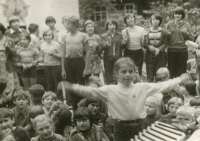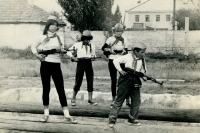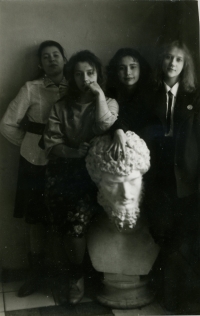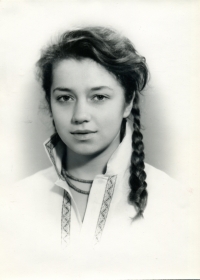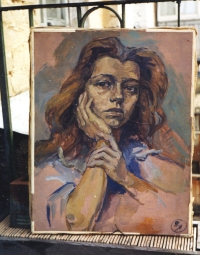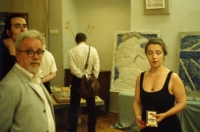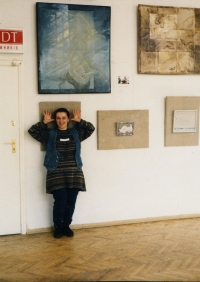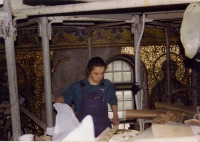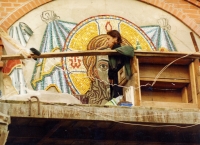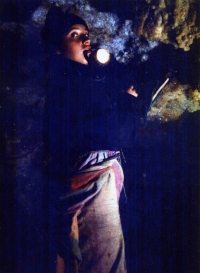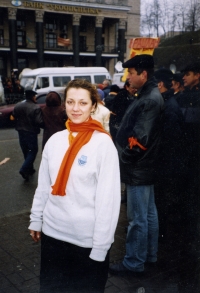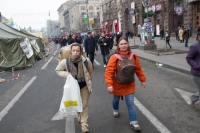“Well, right on the barricade near the Column, the guys were standing. Everything was burning in front of them. That's when I stayed until the evening. Yeah. They were being sprayed with water [from water cannons]. And everything was clanging and rumbling. I walked around, bringing them water, bringing gloves. I don't know, something there doesn't... explosions don't scare me at all. It's just that they are standing on the barricade, all smoky and exhausted. I came to ask something, to bring them water, tea, milk. Right there on the spot, in that tent... that's where I stood in the tent across from the Conservatory, near the subway exit. They were pouring milk there. Because the most... the most in demand was milk to drink. Those “muzzles” were distributed, well, somehow... clothes. Clanging and rumbling. Here is fire, there is water. They're shooting constantly. From time to time, someone would come up and say, “Don't move too much, stay here.” Well, more at night. The only thing is that towards morning... Just visual moments again. But that was around half past six, probably, earlier. Because at night, it was rumbling, clanging, but the night passed more or less peacefully. And the girls who were standing there with me near that little tent — one had to go to school, well, to university, and the other — to work. I say, “Well, you see, we've made it through the night, it's already half past six, or maybe even half past five. Well, probably half past six. I'm telling you, by the time you reach some metro station and get home to clean up, sort things out.” And so they left, and from the moment when some very interesting actions started happening... That's the observation, what I saw. So, on one side, there was this grandfather who stood on the barricade all night, covered in soot, in dirt... So he came up to our little tent, and there was a puddle. And he starts washing his hands in the puddle, wiping something off himself. I say, “Let me give you some water, I have plenty of it.” No, no. He sloshed there a bit. I say, “Maybe you want some water, tea, or something else... Let me really give you some water or change something from your clothes.” Because he was all dirty, black. He says, “No, my child.” So he sloshed in that puddle and went back on the barricade. And right after that, after seven o'clock, the “tourists” started appearing. So this grandpa, dressed in some kind of plastic raincoat, and people fully equipped. They had helmets with all sorts of gadgets, and he had this half-face respirator hanging there, something else. And they just came in that gear to have tea on Maidan. And then people started coming. Well, first of all, those who were standing on the barricade, they kept coming because we had a pile of clothes there to take off the smoked ones and throw them away right there. And put on something fresh and go back to stand there. Or wet. They were all smoky here, being sprayed with water. So someone threw the wet clothes, took some jacket, some sweater, and went back there. And then these “tourists” arrived.
Or again, such a thing that impressed me. Purely visual. Like a movie. If I were to make a film, this must be included... A young guy, well, not a guy, rather a young man. And he came to the tent to change clothes. So he takes off his civilian clothes, and he has two stainless steel plates on chains in place of kidneys. And there's something else covered there. Well, it was visible when he was changing his clothes. And so calmly, in a business-like manner, the person changes, asks to keep an eye on the bag with his civilian clothes, and goes there. That's how it was. A contrast.
Then the massacre began. It was clanging and rumbling even more terrifying than at night. But, as I say, before you arrived, when you came to Maidan with “Dama” [Volodymyr Nasiedkin, a famous Kyiv speleologist, Vice President of the Ukrainian Speleological Association] and Zubkov [Serhii Zubkov, a famous Kyiv speleologist], I have no visual memories. I mean, later when I looked at photos and watched videos, I saw that there were people lying just two meters away from me, but I don't remember anything. It's just that people would come, someone slightly scratched would come because something had grazed them. I was working. I still remember that, but overall, it's as if it got erased. Then at some point, people came and said, “We're already upstairs.” And that's it.”

